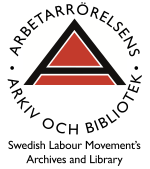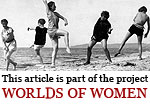 Political tourism in a very broad sense has been important for the Swedish labour movement from the very beginning. Political tourism among women in the Swedish labour movement changed from journeys to the modern Soviet Union during the 1920s, to the war-stricken countries to help their sisters in need, and twenty years later to the Global South in order to support women’s projects in Africa and Asia.
Political tourism in a very broad sense has been important for the Swedish labour movement from the very beginning. Political tourism among women in the Swedish labour movement changed from journeys to the modern Soviet Union during the 1920s, to the war-stricken countries to help their sisters in need, and twenty years later to the Global South in order to support women’s projects in Africa and Asia.
- Download pdf version of this essay:
Tales of Modernity, Peace, and Solidarity – Women’s Travelogues (84 kB)
Have you been on a roller coaster ride for three hours straight, experiencing every ten seconds all the sensations associated with such a ride, then, and only then, do you know how it feels when the young former partisan Miso Radunovic takes the wheel and tears off with somebody up the shelf roads of Montenegro. We were on the way to Dalmatia, Sonja Branting and I; two remaining delegates in a group invited by the Red Cross in Yugoslavia.
Maj Jarke, ‘Resa i Montenegros berg’, in Morgonbris no. 12 1946
Irrespective of distance and language barriers, women have long exchanged experiences with each other across national boundaries, both by means of letters and via personal meetings. This becomes self-evident when one studies historical source material. Archives, for example, contain travelogues in various forms. In personal papers and organizational archives, one can find diary entries, letters describing to others the planning work and later, on arriving home, the traveller’s experiences, or thank-you letters to and from hosts, etc.
The journals published by women’s organizations, however, are a real gold mine when it comes to studying women’s travelogues. These journals contain large quantities of research material. (1) The journals devote a lot of space to communication with sisters in other countries. This is illustrated in everything from mere travelogues, abstracts of foreign newspaper articles, book reviews and translations of poems to reports from international conferences attended.
Judging from the volume of material, there do not seem to be any language difficulties or, in any case, they do not present a barrier to contact. People clearly either have texts translated or there are colleagues with good language skills who can relate the traveller’s experiences to their readership on returning home. The women concerned are largely well educated and members of political organizations, within which they hold relatively high positions-what could be termed elite.
The main starting point for this paper is Swedish travelogues in the journals of two major women’s political federations. The reason for choosing the journals of Sveriges Socialdemokratiska Kvinnoförbund, SSKF [the National Federation of Social Democratic Women in Sweden] and Svenska Kvinnors Vänsterförbund, SKV [the Left Federation of Swedish Women] is-if possible-to provide a somewhat varied political picture, albeit of women in the labour movement. Accordingly, the journal Morgonbris (1904-) will represent the views of the Social Democratic women, and Röda Röster (1919-1930, 1921-1967), Arbetarkvinnornas tidning (1930-1947), and Vi mänskor (previously Vi kvinnor i demokratiskt världsförbund [1947-]) those of women on the Left.
The interpretations given here are based on a limited selection of articles and supplementary material. The paper is not a comprehensive survey of women’s travelogues in general, specific journeys/destinations or the political views described. The aim of the article is to show that journal articles of this nature constitute an important source for research.
The 1930s and the ’Modern Soviet Union’
In the summer of 1934, Morgonbris arranged a study trip to the Soviet Union. (2) In an advertisement in the March issue, ‘the Soviet minister in Stockholm, Madame Kollontay’, bid the Morgonbris readers ‘welcome to Russia!’ It was a fourteen-day study trip by boat from Stockholm to Leningrad and on to Moscow. The advertisement promised a visit to Moscow for the 1 May demonstrations as well as visits to
…workers’ clubs, crèches…factory canteens and the collective dining rooms…hospitals, maternity homes, marriage bureaus, reformatories for ”unruly” children’.
Morgonbris no 3 1934
There was something for everyone-from visits to industrial facilities to trips to the theatre. (3)
A total of thirty-four female and five male participants went and this trip generated a large number of reports in Morgonbris and the discussions also continued in other journals around Sweden.
The collected newspaper cuttings already make up an entire large book, telling of everyone’s gratitude for the opportunity to make this acquaintance with the only workers’ state
Hulda Flood, Morgonbris no. 7 1934
The opinions expressed in Morgonbris were not universally positive, although Elin Wägner was impressed with the level of commitment, comparing this with the situation in Sweden:
The sense of dignity comes from the certainty of full participation…that the broad mass of working people have this sense of participation, unlike here, a handful of members of the Riksdag and office managers.
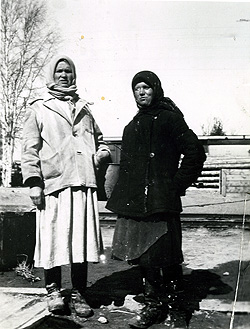
Maj Hirdman wrote in her travelogues about the meeting with the “new worker” in the Soviet Union. Photo: Maj Hirdman. Source: ARAB, Morgonbris.
Maj Hirdman wrote:
Everywhere in factories, in workshops, in the streets, and in new buildings, one meets the worker of the new age: happy, active, hopeful, and altogether free of the disgruntlement and despondency of the West
Morgonbris no 7 1934
Maj Hirdman later returned to the Soviet Union, reporting on her travels in a number of articles in Vi kvinnor i demokratiskt världsförbund 1953-1954.
Interestingly enough, Morgonbris’s first report on the journey bore the headline ‘Morgonbris’s Travellers to Russia Discovered Sweden’. Kaj Andersson concluded her article with the words ‘Sweden is a model country!’ In Russia, she discovered that conditions in Sweden were not so bad after all. They were also disappointed that their hosts preferred to show them a distorted picture of extravagant May 1 processions rather than the everyday lives of ordinary people.
We never managed to make contact with the women. In that respect, our otherwise highly accommodating hosts at Intourist were guilty of a serious omission, insomuch as the purpose of our journey was, first and foremost, precisely to study the current situation of women and children
Morgonbris no 6 1934
Greta Lånström was critical:
No one should believe that the Soviet Union is some sort of paradise…And certainly one understands that the country is run by an iron dictatorship. Public opinion as we know it must not be expressed
Morgonbris no 7 1934
Birgit Hedström felt that
[…] after the visit to the Soviet Union we understand that the Communists do not have so much to fall back on. The Soviet experiment is not for us.
Morgonbris no 6 1934
Even more scathing was Hulda Flood, writing after a meeting with Commissioner Losowski:
‘Communist propaganda and lambasting of Social Democracy, on the other hand, we have at home, so for that there is no need to travel to Russia’
Morgonbris no 7 1934
An extract from a poem in Röda Röster a few years earlier may serve to illustrate the type of ‘Communist propaganda’ to which the Social Democratic women were referring:
…Reddest star in the east, you are the sign of renewal. The flag that flies on the Kremlin is a consolation concealing our salvation in its folds. Russia! With life’s redeeming power you vanquish our souls. The proudest part of my heart remained among the free who had been slaves’
Ingeborg Björklund, ‘Ropet efter lycka’ written after a journey in Russia in 1927, in Röda Röster no 11 1928
At roughly the same time as the Morgonbris journey, Ester Hagberg wrote about her journey in the Soviet Union in Arbetarkvinnornas tidning. She had ‘…on this journey seen and experienced so much of interest’ and was impressed by everything she saw:
Crèches, exceedingly well kept, are to be found at every workplace employing women and there are camps [for the ‘unruly children’ taken into care]. And so they grow up into young men and women able to train for the occupation for which they have the best inclination and aptitude…women in the Soviet Union earn the same pay as men for the same work
‘Något om kvinnor och barn i Sovjet-Unionen’ in Arbetarkvinnornas tidning no 8 1934

Airplane above Moskovskaja on 1 May 1934. Photo: Maj-Hirdman. Source: ARAB, Morgonbris.
The many examples of positive images of the Soviet Union conveyed by left-wing women did not always go unchallenged. Valborg Svensson, the then editor of Arbetarkvinnornas tidning, who had also visited the Soviet Union a number of years earlier in 1937, was criticized much later for her descriptions of the journey. In 1949, she and Gerda Nilsson were accused by the newspaper Stockholms-Tidningen (02/12/1949) of sounding like ‘Bolshevik agitators’.
As mentioned previously, left-wing women continued to travel to the Soviet Union, including much later when the journeys were generally heading in different directions. In 1950, the SKV organized a journey to the Soviet Union. Their impressions were described in the brochure Resa i Sovjet. (4) The opinions expressed in this printed brochure-which could almost be described as a tourist brochure for the Soviet Union-are exclusively positive. According to the brochure, Soviet women were well educated and on an equal footing with men. There was equal pay for equal work, irrespective of gender, and they had a well-developed system of schools, health care, and social security.
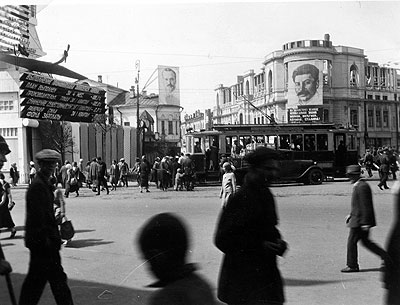
Picture of Molotov and Stalin taken in May 1934. Photo: Maj Hirdman. Source: ARAB, Morgonbris.
This limited material reveals a dividing line between left-wing and social democratic women in their experiences of the modern Soviet Union. Social democratic women were generally more critical, while left-wing women were so impressed that the image they conveyed appears too good to be true. What are the factors influencing these images? Perhaps there is a political agenda behind the reporting? What is the significance of possible preliminary studies, and how large a role is played by the women’s own political identity? The material prompts many new questions.
The Horrors of War and Causes for Rejoicing
The Second World War severely affected the everyday lives of many women and children but also hampered the traditional transnational contacts. Despite both physical obstacles, i.e. convoys fraught with danger, and psychological barriers in the form of new conflicts and frosty relations between nations, women in political organizations continued to travel. The journeys now also had a more distinct uniting and reconciling effect.
Italian women longed for contact with women in Sweden, wrote Elly Jannes, who, when the war was over, travelled through southern and south-eastern Europe:
…they so much wanted some form of connection with Swedish women, who they thought had moved so far ahead of them, and they so much wanted advice.
‘Partisankriget väckte Italiens kvinnor’ in Morgonbris no 6 1946
During the war, the women had been an important part of the resistance movement but afterwards, when the men returned, society required them to return to their homes and children:
Yes, in times of war even the women are needed’, said Loreta, and ‘a little while ago, it was the highest virtue to work; now it is the worst sin. A little while ago we could join in the game; now the big boys are coming back and driving us out’. It was, first and foremost, men of the Church, who moralized on women’s liberation. But with their newly found self-confidence, the women of Unione Donne took up the fight for women’s rights. In this respect, the war had a positive impact
Ibid.
See also corresponding portrayals of Swedish conditions described by Johanna Overud in her work on Swedish women’s work during the Second World War. (5)
Maj-Britt Inghe also visited her Italian sisters a few years later. She confirmed the picture and described the difficult conditions the women in particular were living under: unemployment, housing shortages, and 70-75% illiteracy.
There seems to be no form of organized social welfare as we would understand it; what there is, in this respect, is mainly charity organized by the Church. Medical care is also poor, infant mortality…high.
She continued:
Italy’s women demand that the resources that are available and currently being used for war preparations be used instead for peaceful construction. For the women of Italy, who, after all, have experienced the horrors of war up close, the struggle for peace is the most important of all. And in this battle Unione Donne Italiana is a force to reckon with’
‘Vad Italien behöver’in Vi kvinnor i demokratiskt världsförbund no 5 1953
Article after article shows that contact boosted self-esteem for women on both sides-visitors and hosts alike. ‘Now we Socialist women must seriously start to spend time again with each other’, wrote Henriette Clement, chair of the Federation of Social Democratic Women in Luxembourg, in a greeting the federation sent back with Signe Höjer after her visit.
Tell the women of Sweden that we long to be able to come and make their acquaintance. And tell them that we admire Morgonbris, which we here in Luxembourg receive a copy of each month. Of course, we do not understand the language, but we enjoy seeing all the pictures, which tell us a great deal about your country. There is no women’s federation with such a journal.
In the article, she also reported on a political project that sought to involve women, through practical work, in ‘foyers de la femme’ or meeting places for women. Swiss women had contributed interior fittings to these. When it came to contact with German women, there was a certain hesitance. Clement said:
It is still too early to seek contact with German women…You must understand that we were occupied throughout the war, more than 10,000 young boys were taken from our country to the German army, and we have no information on 3,000 of them. Our country was badly hit by bombing and looting in some places, particularly in the border districts’
‘Resa i efterkrigseuropa till konferenser i operettland’ in Morgonbris no 9 1946
But despite the retarding effects of the war, there was an ambition to cautiously overcome the obstacles and resume these important contacts.
The alienating effects of the war are also illustrated in a personal letter by a German woman, Gertrud Seeman, relating her experiences on her journey to Sweden in 1947. So soon after the end of the war, the attitude to Germans was generally extremely hostile, she found:
My first impression on the journey to Sweden, when we boarded the Nordexpressen train in Hamburg, was feeling-as a German-exactly how we had once made the people we had defeated feel. The words ”This compartment is not for Germans” hit us like a barrage of hate, and people spread themselves out so that none of us could possibly find anywhere to sit, and also said that all the free seats were taken.
ARAB Manuscript Collection, Gertrud Seeman, Våra intryck – är Sverige verkligen ett paradis – hur känner sig en tysk i ett fredsland?
Despite the cool initial reception, she studied her Swedish comrades with great curiosity, appreciated the hospitality extended to her all the same in the latter part of her stay, and came to the conclusion that the journey had provided her with new knowledge that she very much wanted to disseminate.
Perhaps one day we will be able to pay off part of our debt to our Swedish comrades; perhaps one day we will be able to show them that their example gave us the courage, despite the ruins and misery, to build a new and better world? Who knows?’
Ibid.
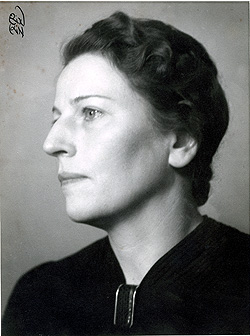
Andrea Andreen (1988-1972), president of Swedish SKV between 1946-1964. Photo: (No information). Source: ARAB, Morgonbris.
Perhaps travelling and the women’s efforts to bring about peace also overcame possible differences of opinion in the Swedish arena? Andrea Andreen, who was chair of SKV, was commissioned by her federation and the Swedish Federation of Social Democratic Women to report from the international women’s congress in Paris in November 1945, at which the Women’s International Democratic Federation was founded.
After the formation of this organization, Andrea Andreen wrote in Morgonbris:
A strong International Federation of Democratic Women is a powerful peace factor. Already we are forming a chain around the world. Each and every one of us can help to make the chain tighter and more secure-so that it holds…I owe a debt of gratitude for this to the National Federation of Social Democratic Women in Sweden, which was one of the organizations who commissioned my work.
Morgonbris no 1 1946
Andrea Andreen was one of the most assiduous left-wing women travellers. In October 1953, she visited ‘Irma Bandiera’, a newly established school for women situated just outside Rome:
During the three years the school has been open, approximately 500 women have been taught there. The courses vary in type depending on the campaign in question-for a conference, for work with children, for better housing, for 8 March, etc.
Moreover, she wrote
‘I thought of the Citizens’ College for Women at Fogelstad of course, and wished that the Left Federation of Swedish Women had any college at all…’
‘Från Rom till Kalkutta’ in Vi kvinnor i demokratiskt världsförbund, no 8-9 1954
New Worlds, New Aims
Twenty years later, people were travelling to different parts of the world. According to the journals, there were new battles to be fought in Africa, Asia, and Latin America. While European women had established good conditions for a better and more equal existence since the Second World War, sisters beyond Europe’s borders were still living in very difficult conditions. The reasons were often poverty and the fact that the women were subjected to twofold oppression in the wake of colonial forms of government and traditional power structures. In the spirit of solidarity, the study trips now concentrated on these remote locations. The Social Democratic Women in Sweden published a brochure entitled ‘KvinnoSolidaritet. Kvinnorna i Mocambique behöver vårt stöd i sin kamp för att vidareutveckla sitt land’ [Female Solidarity: Women in Mozambique Need Our Support in the Struggle to Develop Their Country]. The brochure called upon all members to provide economic support to the newly formed OMM, Organização da Huhler Mocambicana, Frelimo’s Women’s Organization, founded in 1973. At the same time, a message on acting in solidarity was communicated in the ten-point programme ‘How to Show Our Solidarity’.
‘Kvinna utan ansikte – den indiska bykvinnan’ [Woman without a Face – the Indian Village Woman] was the title of Ulla Torpe’s account of her travels in India, in which she conveyed a picture of the miserable situation of poor women.
The Indian village woman-together with the man-is stuck in a social system created thousands of years ago.
Vi mänskor no 2 1975
During her stay, however, she also heard reports of courageous women who, inspired by Mahatma Gandhi’s ‘campaign of civil disobedience’, were trying to break free of the traditions to which they were in thrall, and she concluded hopefully:
What we can hope for is a Freire-inspired offensive, led by politically conscious women and men with the capacity for close human contact. More than 200,000,000 Indian women are waiting to finally show their faces
Ibid.
At roughly the same time, the following comment was heard from Africa: ‘The woman shall be a flower that the bee seeks’. Birgit Hedberg, who had travelled to Zambia with a group of Scandinavian women, was indignant at the words of her hostess.
Madame Kankasa outlined a view of women that we were unable to reconcile ourselves to, and that we cannot believe produces a society where men and women are equal…The role of the woman in Zambia is quite clear: she is responsible for giving birth to children, raising children, housework, and-to a certain extent-providing for the family. The man is responsible for making the decisions in the family. He earns the money and does not involve himself in the woman’s role
Morgonbris no 5 1975
Probably from the same journey to Zambia, Louise Waldén reported in Vi mänskor:
Certainly the usual picture of women in developing countries is also true, namely that they are working animals, worn out from bearing too many children, and uneducated…In Zambia, we learnt that the woman has equal status in society but is subservient to the man in the family.
’Jämlika män ser män som överhuvuden’ in Vi mänskor no 1 1976
She thought that the position of women had, if anything, deteriorated in the coming together of the traditional Zambian culture, the colonial power, paid employment, and urbanization. In the light of her observations, she proposed a focus on policy:
…I believe that what is required is vigilance and awareness of the development not only among our Zambian sisters, but also among ourselves…steering contributions and aid in a direction that strengthens the position of women’
Ibid.
Both travellers to Zambia, Birgit Hedberg and Louise Waldén, also have something to say through their accounts about the society they themselves live in. Compared with the Zambian women, Swedish women of the 1970s were (more) equal: they had a job, their children were looked after, and the men did (a large) part of the housework.
A similar picture of rural women emerges from Latin America. Like their Indian and African sisters, they are right at the bottom of the social ladder. ‘In Latin America, the oppression of women is total’, Birgitta Ek asserts. ‘At the top of the pyramid is the rich white man, then his white wife, and right at the bottom the destitute Indian or half-breed woman’. Birgitta Ek managed to find a bishop who believed that female liberation also favoured men:
If you want to achieve freedom, you must begin in your own home. Your women are exploited and forgotten. The women must be with us; they are our companions and comrades…Encourage them, help, awaken, organize!
‘Kvinnoförtryck – människoförtryck’ in Vi mänskor no 2 1975
There were also examples of women who worked for the resistance, but these were among students and guerrillas.
’Women on the barricades are rare among the most vulnerable in Latin America…China and Vietnam have shown that a revolution can aim to liberate women from their position at the bottom of the human ladder where cultural patterns and traditions have placed them since time immemorial’
Ibid.
With that it could also be said that the last-named writer has nailed her colours to the mast, i.e. women should bring about revolution as in Communist countries. Only then would they be able to achieve full equality with men. A simple conjecture is that a Social Democratic writer would probably have encountered considerable opposition if she had propagated for revolution as a solution. It is also important to highlight the fact that the writers are well-educated women from urban, sophisticated societies, who were studying and comparing their experiences with those of poor, uneducated women in rural districts. The consequences this had for possible interpretations and subsequent actions on arriving home are interesting questions to answer.
Summary
There is a long tradition of women travelling to exchange experiences across national borders and then writing about this in the journals of their own organizations. These journals are full of travelogues of this type, and constitute a rich source of research.
It is not always clear from the articles why someone travelled. Most of the travelogues are empirical descriptions of the actual journey: start and finish time, route taken, places visited, concrete descriptions of visual impressions, and emotional reflections. The purpose of the travel reports is to render a perception, share experiences, possibly convey a political message, and send thanks to one’s hosts. What they all have in common is that it is women experiencing and documenting the living conditions of other women and/or children.
The reports display great breadth, depending on the writer and the purpose of the journey. There are examples of everything from purely tourist trips to participation in international conferences with a set programme of predetermined places to visit. Some write a poetically coherent report, while others purely provide descriptions of their experiences in chronological order; some single out scapegoats, while others philosophize on advantages and disadvantages.
The travel reports are sometimes distinctly coloured by political ideology. Most of the articles have both a descriptive and a moralizing component. Views on how things should be vary from writer to writer. Most of the writers are well-educated women holding high positions within their respective organizations. As intimated, there is also sometimes a difference between the views of Social Democratic and left-wing women on solutions and explanations for their observations.
In terms of the journeys made by both social democratic and left-wing women, the same patterns can be discerned in which destinations are popular at different times. The destinations probably varied depending on the social climate and general political situation. Thus, journeys to the Soviet Union were most frequent in the 1920s and 1930s, while interest in studying the war-torn parts of Europe was great after the Second World War. As the 1970s approached, and in the spirit of solidarity typical of the period, destinations expanded to include Africa, Asia, and Latin America. The international exchange broadened horizons for the individual and policy alike. Travelling brought women closer together on a personal level and increased political involvement.
The articles provide an indication of how different people with various starting points may describe reality in different ways. The reports contain a wealth of information on gender and power structures, where the level of education, social development, poverty, and equality are key components.
Archival materials and printed sources
ARAB Manuscript Collection
ARAB Studieresor till Sovjetunionen
Journals
Arbetarkvinnornas tidning
Morgonbris
Röda Röster
Vi mänskor (previously Vi kvinnor i demokratiskt världsförbund)
References
- Joan Sangster discusses and provides examples of this from Canada in ‘Political Tourism, Writing, and Communication: Transnational Connections of Women on the Left, 1920s-1940s’ in Pernilla Jonsson, Silke Neunsinger, and Joan Sangster (eds.), Crossing Boundaries: Women’s Organizing in Europe and the Americas, 1880s-1940, Uppsala, 2007, 95-11.
- For an overview over the collections concerning the Soviet Union see Lars Gogman, ’The tears welled up unbidden in our eyes…’ The Soviet Union’, in Martin Grass, Gunilla Litzell & Klaus Misgeld, The World in the Basement. International Material in Archives and Collections, Stockholm 2002, 1-51.
- Morgonbris no 3 1934.
- Resa i Sovjet: utgiven av Svenska kvinnors vänsterförbund’ Katrineholm 1951.
- Johanna Overud, I beredskap med Fru Lojal: behovet av kvinnlig arbetskraft i Sverige under andra världskriget, Stockholm 2005.
